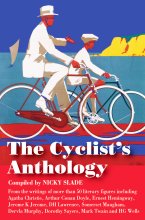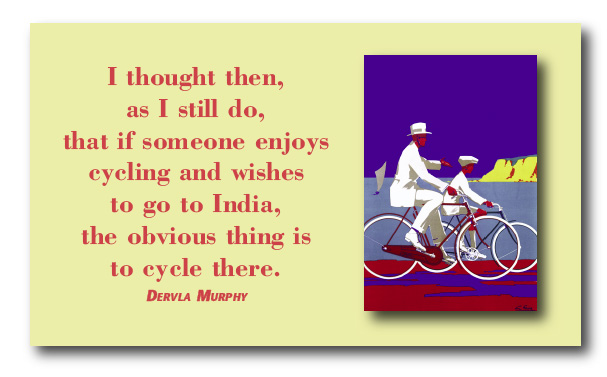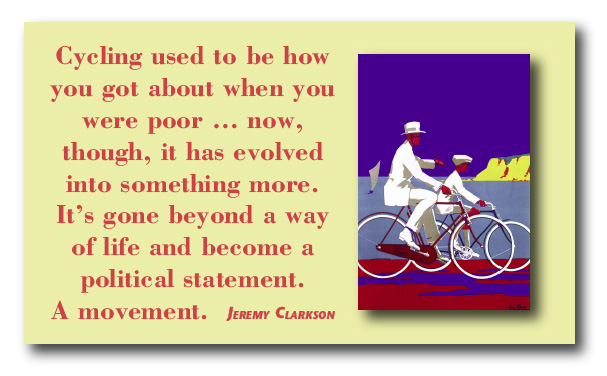I've said it before and I'll say it again, Trailblazer guides take some beating.
— Adventure Travel

The Cyclist's Anthology
Excerpt:
Introduction
Contents | Introduction | Sample 1: A Passage to India (E.M. Forster, 1924) | Sample 2: Tandem Trouble, 1914 (Jerome K. Jerome) | Sample 3: Mulga Bill's Bicycle, 1896 (A.B. 'Banjo' Paterson)
Introduction
While the basic design of a human-powered vehicle comprising a wooden frame on two in-line wheels had already been in existence for some time, in 1817 Baron Karl von Drais added a rudimentary steering mechanism. This simple development drastically improved balance as well as the more obvious directional control and, with that, the ancestor of the modern bicycle was born.
Most of us learn to ride a bike as a child and barely remember our first foray on two wheels, any more than we remember our first steps, but imagine how the fear of falling would haunt the attempts of the average adult learning to ride a bicycle for the first time. Then imagine if that adult rider was seated over a metre off the ground on a penny-farthing bicycle with the pedals on that tall front wheel! So the introduction of a chain-drive system in the 1880s, enabling the pedals to turn the rear wheel rather than the front one, was a significant advance in making it more user-friendly.

This was undoubtedly the first step towards cycling for the masses, and brought a truly universal mode of transport into the world, available to young and old, rich and poor, city-dweller and countryman, commuter and cycle-tourer alike. Upon mastering the mystery of balance, something that cannot truly be ’taught’, only imperfectly explained and acquired through practice, almost anyone from young children to the elderly can propel themselves to school, work or out into the wide world.
Further refinements have since been made with gears and revolutionary materials that reduce the weight of the machine, but the fact remains that the basic design is very little changed in well over 100 years.
Although in Britain in the early and mid 20th century the bicycle was often the most practical choice of transport for work purposes (postmen, policemen, district nurses, delivery boys), fast forward to the 21st century and the car has taken on the majority of those roles. While it might still be used for city commuting or by cycle couriers, the bicycle now features far more in the leisure and sport arenas for most. In less developed countries, such as China and India, the bicycle continues to rule supreme. China still has nearly half of the world’s population (estimated at over a billion) of bicycles but even there the car is beginning to win out over pedal power.

Similarly in literature, while the humble bicycle has often been there in the background, it has rarely taken centre stage.
So this anthology brings it into the spotlight, showing how, as well as being a tool for those with a job to do, from serving the community to solving crimes, it has been a means of immersing ourselves fully in other cultures and natural environments, a self-sufficient method of carrying our own little world wherever we wish to explore, to bond with companions or meet new friends. For a child it may have been a status symbol like the Raleigh Chopper in the 1970s (ideally in purple, like my brother’s) or a BMX bike in the 1980s. For an adult it may be a means of facing a personal challenge, overcoming a mental crisis or turning a dream into reality.
But whatever your own personal experience of bikes and cycling, the key theme that emerges from much of the writing in this anthology is one of the bicycle as liberator: for women, from the confines of uncomfortable restrictive clothing and the need for a chaperone; for the poor, who previously could only rely on their own two feet for transport; for the thrill-seeker on any downhill run; for the child with a sense of adventure; for the traveller, who could carry enough to be self-reliant yet still interact with the people and landscape through which he or she travelled.
I’ll finish with the words of 19th century author Mark Twain who, on concluding his account of his own efforts to learn to ride the terrifyingly-challenging penny-farthing as an adult (see p11), offers the following incisive and succinct imperative:
Get a bicycle. You will not regret it – if you live.
Nicky Slade, West Sussex, 2015
The Cyclist's Anthology
Excerpts:
- Contents
- Introduction
- Sample 1: A Passage to India (E.M. Forster, 1924)
- Sample 2: Tandem Trouble, 1914 (Jerome K. Jerome)
- Sample 3: Mulga Bill's Bicycle, 1896 (A.B. 'Banjo' Paterson)
Price: £4.99 buy online now…
Latest tweets